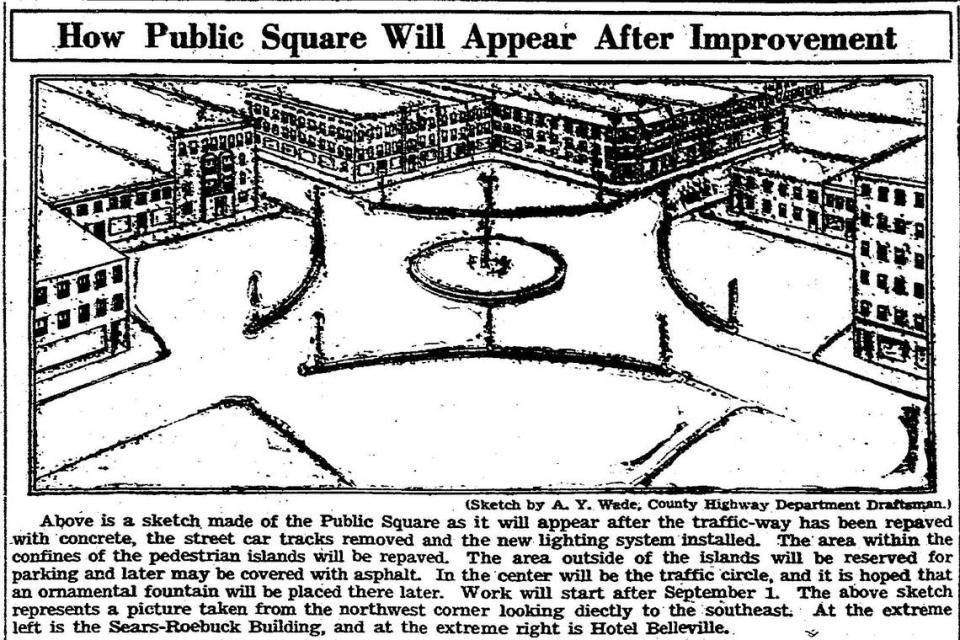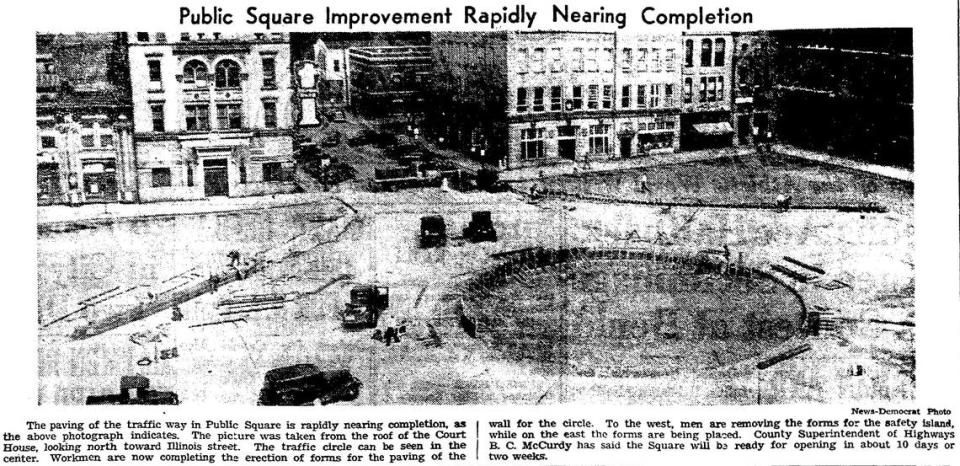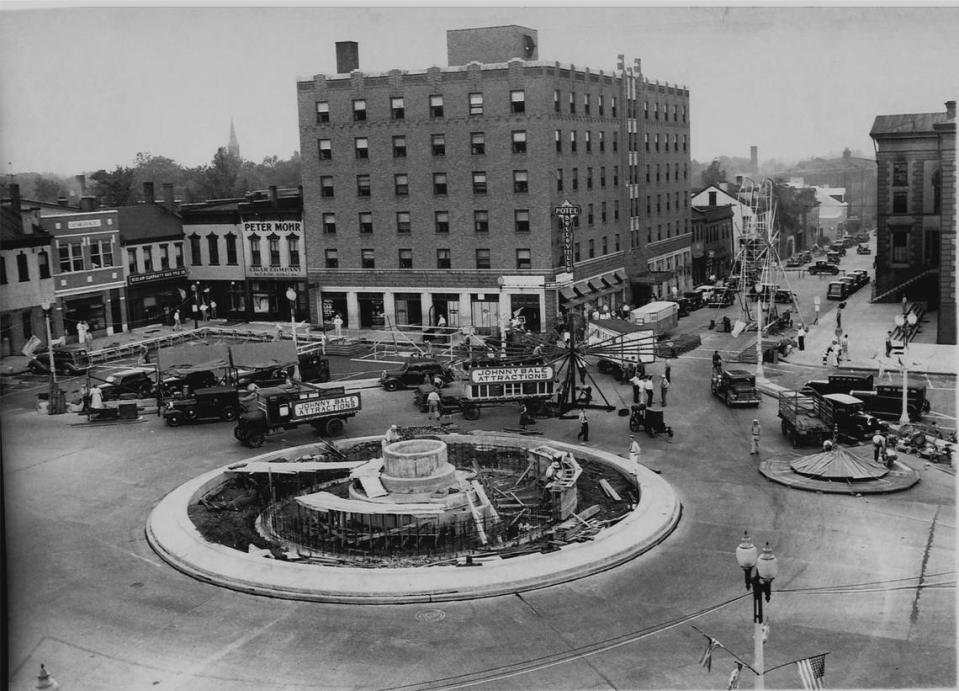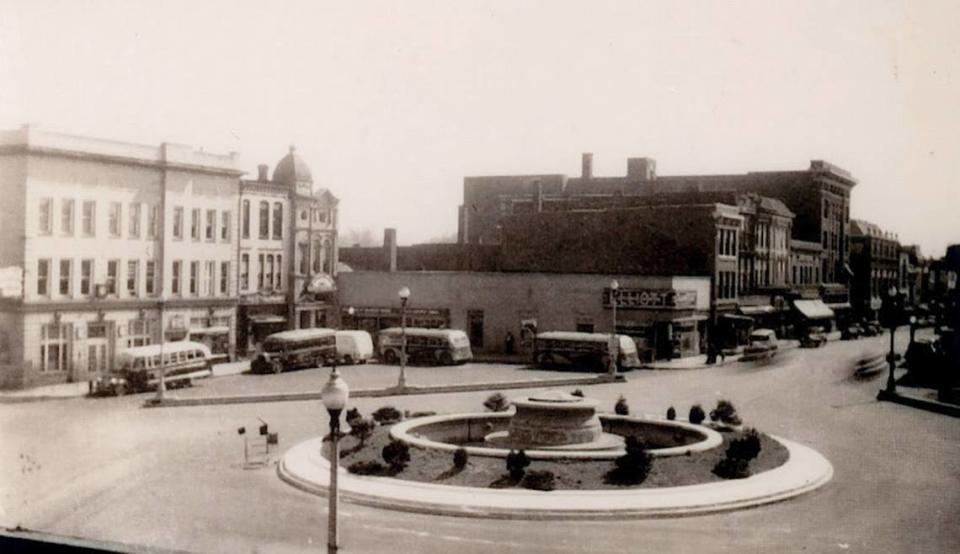Driving around the traffic circle at Belleville’s iconic Public Square can be an adventure
As my friends and I acquired driver’s licenses in high school, one of the things to do on the weekends was to go cruising.
It was nothing like “American Graffiti,” of course, but it passed the time when there wasn’t much else for bored teenagers to do on a Friday or Saturday night.
Cruising around New Baden or Trenton didn’t take long, so we ventured elsewhere. Breese, Highland, Fairview Heights … and Belleville.
Thirty years later, I still remember the time I was in the driver’s seat, driving around the Veterans Memorial Fountain at Belleville’s Public Square with a couple of my girlfriends, and almost died.
OK, I’m being dramatic. It really wasn’t an ohmygod-we’re-gonna-die! moment. Nowhere near it.
It was an I’m-in-the-roundabout-and-almost-got-sideswiped-by-another-driver moment.
No big deal, and I lived to tell the tale.
The roundabout on Public Square has been a part of our lives in Belleville for decades, whether it’s figuring out who has the right of way (The vehicles in the roundabout do, but many of us have been confused over the years. More on that later.) to the beauty of the fountain with its sunlit sprays during clear days and lovely lighting at night.
So when did Belleville add the traffic circle to Public Square? I happily went back into the BND archives to find out.

A new and improved Public Square
In 1936, St. Clair County’s Board of Supervisors allocated $20,000 for the improvement of Public Square.
At that time, the intersection of Illinois and Main streets was a regular four-way intersection, very unlike what we’re used to today.
Plans drafted by then County Superintendent of Highways B.C. McCurdy included “repaving of the street, a system of traffic control and much better illumination of the center part of the downtown section,” stated a June 9, 1936, article in the Belleville Daily News-Democrat.
A few weeks later, McCurdy revealed that the project would entail the removal of the brick in the driving areas. Brick would remain in the parking areas at each corner of the intersection. The streetcar tracks at the square’s center would also be removed.
“The four large ‘white-way standards’ [light poles] in the center of the square most likely will be taken down and the center will be marked by an ornament of some kind, probably a fountain,” stated a June 29 article.
The brick in the traffic area would be removed but would remain in the spaces adjacent to the curbing to be reserved for parking.
Islands with ample lighting would be installed at the corners of the square to separate moving traffic from parking areas and for pedestrians’ safety.

(By September, the city decided that the square’s new design would be impractical for jaywalking. Any pedestrians caught “cutting across the Square” could be arrested, according to a Sept. 3, 1936, story.)
City Supervisor Herbert Schwind would solicit contributions from local businesses to pay for an electric fountain that would be the centerpiece of the traffic circle.
Work on the Public Square intersection started Sept. 1, 1936, after the Junior Chamber of Commerce street fair and homecoming held a few days earlier.

The new and improved Public Square was completed in little more than a month, reopening to traffic on Oct. 3, 1936, as work on the parking areas on the corners continued.
BND Public Square 1936 Clips by Jennifer Green on Scribd
Work relating to the fountain began Tuesday, April 13, 1937, with the turning of the first spadeful of earth, followed by the digging of trenches to determine exact locations of utility pipes.
Construction for the fountain started May 22. On Oct. 23, the first Veterans Memorial Fountain was formally dedicated.
In 1985, after nearly 50 years that included occasional updates and repairs, multiple veterans groups campaigned to raise funds for the fountain’s renovation. In February 1986, work started to remove the concrete sections of the original fountain.
Replacement of the concrete sections with a granite cone took place in April 1986. By this time around 85% of the electrical and plumbing work was completed.
On Saturday, May 3, 1986, a dedication ceremony took place for Veterans Memorial Fountain, version 2.0.
The fountain’s original base is now located at Melvin Price Memorial Park in Swansea.


BND Public Square 1937 Clips by Jennifer Green on Scribd
Right of way in a roundabout way
Belleville Public Square’s roundabout is a landmark in the metro-east.
In recent years, additional traffic circles have been added in Belleville, as well as in O’Fallon, Highland and other communities to help alleviate heavy traffic flow.
On the night of my “near death” experience, I should’ve learned that being in the Public Square roundabout did not give me the right of way. At least that was the case at the time.
The official rule today is that vehicles in the roundabout have the right of way.
But for a long time, it remained unclear to me who had the right of way. This was an issue for other drivers too.
In April 1984, the News-Democrat asked metro-east residents who had the right of way in Belleville’s Public Square.
The answers varied. Drivers on Main Street had the right of way. Those in the roundabout had it. Someone said he avoided the Square altogether to not have to deal with it.
Jim Goodwin, a traffic sergeant with the Belleville Police Department, stated in the article that he didn’t know if there was a law to govern the right of way on the Square.
In an April 1987 Answer Man column, Roger Schlueter replied to a reader who asked if there was a way to determine who had the right of way.
He replied, “Funny you should ask — I’ve been living here 34 years and I’m still wondering.”
Roger wrote that according to then City Clerk Art Baum, the person on the right has the right of way.
“If you are in the traffic circle and you meet another car approaching from Main or Illinois Street, you’re supposed to be a good Josephine and let that car into the circle before you proceed,” he wrote.
“Hopefully, they’ll cooperate and take turns going around,” Baum stated at the time.
Of course, this didn’t always happen.
Most people seemed to know how to successfully navigate the traffic circle. Then in 2008 the unofficial rule was changed to match what is required by the state of Illinois: The vehicle in the roundabout has the right of way.
Yield signs for drivers approaching the square and crosswalks with signs to yield to pedestrians were added.
It took time for residents and regular visitors to get used to it. Even now, I occasionally see drivers who don’t follow this rule.
Still, I figure as long as I don’t get sideswiped or stuck in the roundabout like the Griswolds in “National Lampoon’s European Vacation,” it’s a good day.
BND Roundabout Right of Way Clips by Jennifer Green on Scribd
BND Public Square Renovation 1970s by Jennifer Green on Scribd
BND Public Square Fountain Renovation 1986 by Jennifer Green on Scribd


